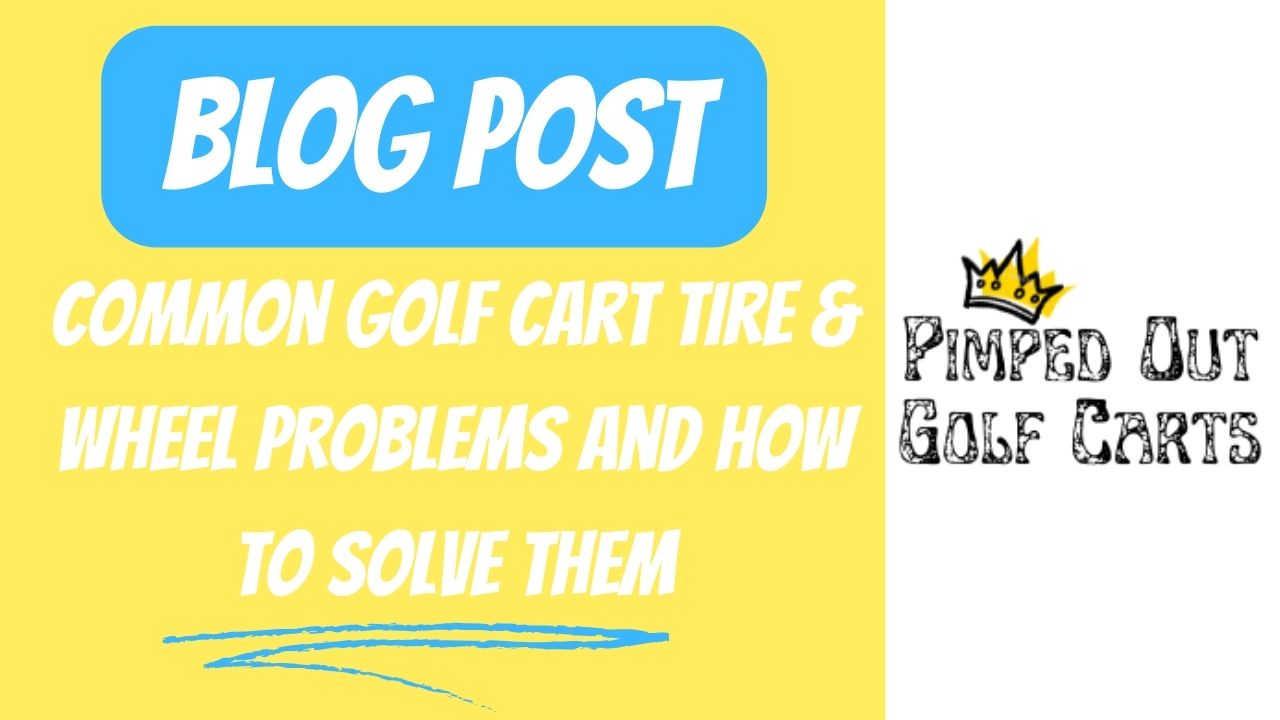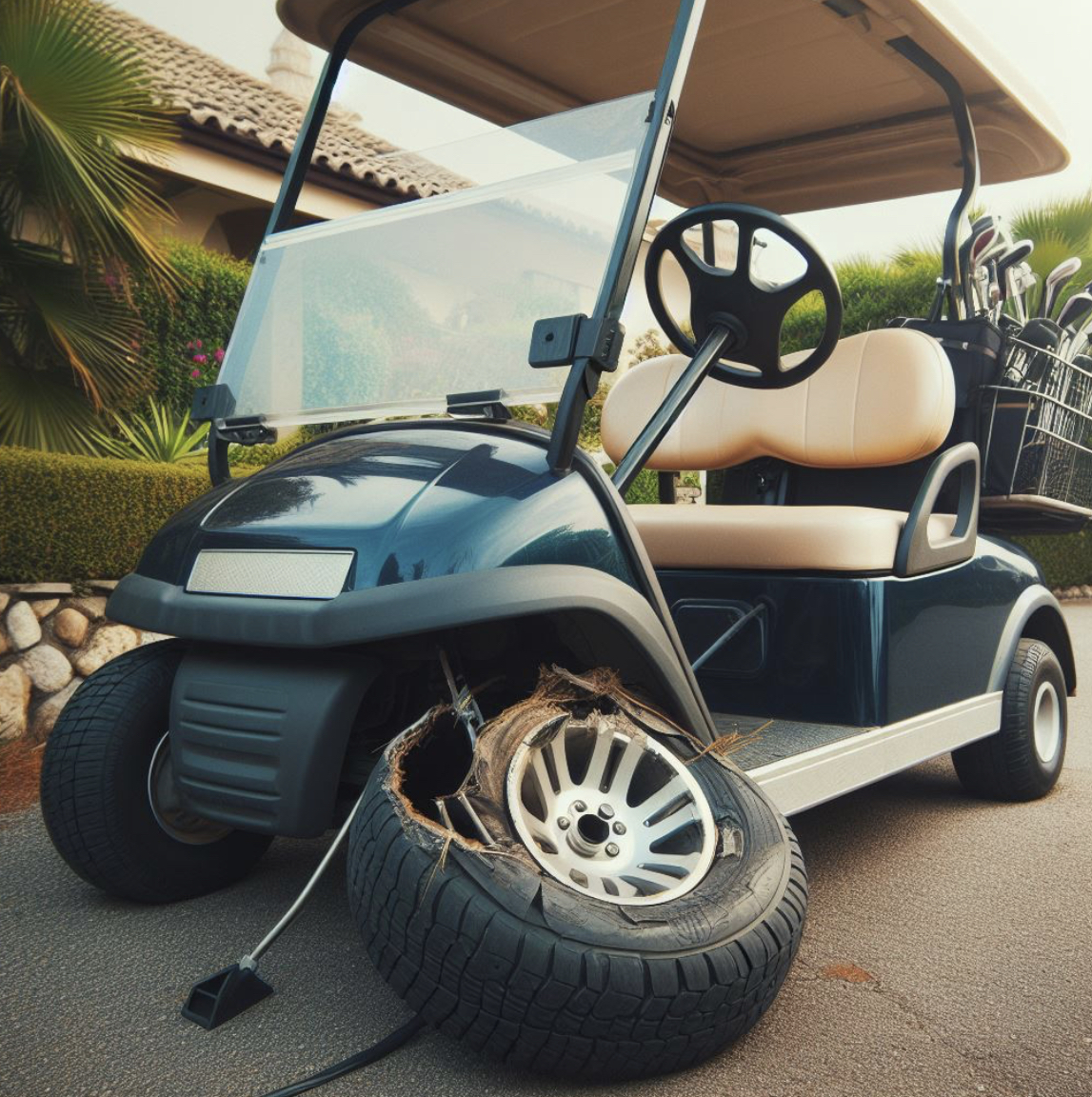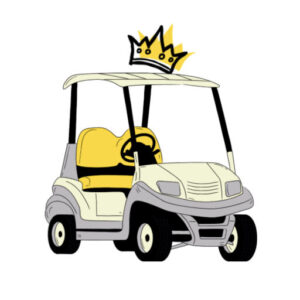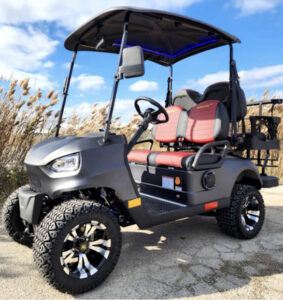
Today, we’ll dive into common golf cart tire and wheel problems and how to solve them. To help you understand golf cart tire and wheel maintenance, we will explore the most prevalent issues encountered by owners and provide practical solutions for resolving them. Whether you’re a seasoned golfer, a golf course manager, or simply a golf cart enthusiast, understanding and addressing these issues promptly is essential for ensuring smooth rides and enjoyable rounds on the green.
Golf carts serve as essential companions on the fairways, providing convenience and mobility for players and staff alike. Yet, amidst the smooth rides and leisurely rounds, there lies a crucial component often overlooked: the tires and wheels. These seemingly simple components play a pivotal role in the safety, stability, and overall performance of golf carts.
However, like any vehicle, golf carts are susceptible to tire and wheel problems that can disrupt play and pose safety hazards. From flat tires to uneven wear and alignment issues, these common challenges can put a damper on any golfing experience if left unaddressed.
So, whether you’re facing a pesky flat tire or noticing uneven wear on your wheels, we’ve got you covered with expert tips and insights to keep your golf cart rolling smoothly.
Understanding Common Golf Cart Tire And Wheel Problems
Golf carts, like any vehicle, are not immune to tire and wheel issues. Among the most common problems faced by golf cart owners are flat tires, uneven wear and alignment issues.
Flat tires can occur due to punctures from sharp objects on the course or simply from wear and tear over time. Uneven wear, on the other hand, can result from improper tire inflation, lack of rotation, or misalignment, leading to compromised performance and safety.
Alignment issues, while less frequent, can cause the cart to pull to one side or experience vibrations, affecting the overall driving experience. It’s essential for golf cart owners to recognize these problems early on to prevent further damage and ensure the longevity of their tires and wheels.
By understanding the root causes of these common issues, golf cart enthusiasts can take proactive measures to address them and maintain optimal performance on the course.
Solutions for Flat Tires
Flat tires are a frustrating but common occurrence for golf cart owners. Whether it’s a result of running over debris on the course or gradual air leakage, a flat tire can quickly put a halt to your golfing plans. However, there are several proactive measures you can take to prevent and address flat tires effectively.
First and foremost, maintaining proper tire pressure is paramount. Regularly check your tire pressure using a pressure gauge and inflate them to the manufacturer’s recommended PSI (pounds per square inch). Under-inflated tires are more susceptible to punctures and wear unevenly, so keeping them properly inflated can significantly reduce the risk of flats.
Additionally, conducting routine inspections of your tires can help identify potential issues before they escalate. Look for signs of wear, such as cracks, bulges, or embedded objects, and address any abnormalities promptly. If you do encounter a flat tire, don’t panic—repair kits specifically designed for golf cart tires are readily available and easy to use. These kits typically include a plug, reamer, and insertion tool for patching up punctures quickly and effectively.
In some cases, however, a flat tire may be beyond repair, especially if the damage is extensive or located in a critical area of the tire. In such instances, replacing the tire entirely may be the most viable solution. Consult your golf cart’s manual or a professional technician to ensure you select the correct tire size and type for your cart.
By staying vigilant with tire maintenance, conducting regular inspections, and having the necessary tools and knowledge to address flat tires promptly, golf cart owners can minimize downtime and keep their carts rolling smoothly on the green.
Addressing Uneven Wear
Uneven wear on golf cart tires is a common issue that can lead to decreased performance and premature tire replacement. Fortunately, there are several steps you can take to identify and rectify uneven wear patterns, ensuring optimal traction and stability on the course.
One of the primary causes of uneven tire wear is improper tire inflation. When tires are under-inflated, the outer edges of the tread bear the brunt of the load, resulting in accelerated wear along the shoulders. Conversely, over-inflation can cause the center of the tread to wear out more quickly.
To combat this, regularly check and adjust your tire pressure according to the manufacturer’s recommendations to ensure uniform wear across the tread surface.
In addition to maintaining proper tire pressure, routine tire rotation is essential for distributing wear evenly among all four tires. By periodically swapping the front and rear tires as well as crossing them from side to side, you can mitigate the effects of uneven wear and prolong the lifespan of your tires. Aim to rotate your tires every 6,000 to 8,000 miles or as recommended by your golf cart’s manufacturer.
Furthermore, wheel alignment plays a crucial role in preventing uneven tire wear. Misaligned wheels can cause the tires to toe in or toe out, leading to excessive wear on one side of the tread. Symptoms of misalignment include steering pull, vibrations, and uneven tire wear patterns. If you notice any of these signs, have your wheel alignment checked by a qualified technician and adjusted as necessary to ensure proper alignment and tire wear.
By implementing these proactive measures, golf cart owners can address uneven tire wear effectively and extend the lifespan of their tires. By maintaining proper tire pressure, rotating tires regularly, and ensuring wheel alignment, you can enjoy smoother rides and improved performance on the green.
Troubleshooting Wheel Alignment Issues
Wheel alignment plays a crucial role in the overall performance and handling of a golf cart. When the wheels are properly aligned, they point in the same direction and are parallel to each other, ensuring stability, steering responsiveness, and even tire wear. However, misaligned wheels can lead to a host of problems, including steering pull, vibrations, and uneven tire wear.
If you suspect that your golf cart may have wheel alignment issues, there are several telltale signs to watch out for. One of the most common indicators is steering pull, where the cart veers to one side even when driving on a straight path. This can be particularly noticeable when driving at higher speeds or on uneven terrain. Additionally, you may experience vibrations or shaking in the steering wheel, which can indicate misaligned wheels or imbalanced tires.
To troubleshoot wheel alignment issues, start by visually inspecting the alignment of the front wheels. Stand in front of the cart and check if the wheels appear to be pointing in the same direction. If one wheel is visibly turned inward or outward compared to the other, it’s likely misaligned and requires adjustment.
Another method for diagnosing wheel alignment problems is to perform a hands-on inspection of the tires. Run your hands along the tread surface of each tire and feel for any irregularities or uneven wear patterns. If one side of the tire tread is significantly more worn than the other, it could be a sign of misalignment.
If you suspect that your golf cart has wheel alignment issues based on these visual and tactile cues, it’s essential to have the alignment checked and adjusted by a qualified technician. Attempting to adjust the alignment yourself without the proper tools and expertise can lead to further problems and compromise the safety of your cart.
A professional wheel alignment service will involve measuring the alignment angles of the wheels and making precise adjustments to ensure they are within the manufacturer’s specifications. This may require adjusting the camber, caster, and toe angles to achieve proper alignment and optimal tire wear.
By addressing wheel alignment issues promptly, golf cart owners can improve steering responsiveness, reduce tire wear, and enhance overall safety and performance on the course. Regular maintenance and periodic alignment checks are key to preserving the integrity of your golf cart’s suspension system and ensuring a smooth ride for years to come.
Maintenance Tips for Prolonging Tire and Wheel Lifespan

Proper golf cart tire maintenance is the key to prolonging the lifespan of your golf cart’s tires and wheels, ensuring optimal performance and safety on the course. By implementing these simple yet effective maintenance tips, you can minimize wear and tear, prevent common problems, and maximize the longevity of your tires and wheels.
Regular Inspections: Make it a habit to visually inspect your tires and wheels before each outing on the golf course. Look for signs of damage, such as cuts, bulges, or embedded objects, and address any issues promptly to prevent further damage.
Tire Pressure Checks: Maintaining proper tire pressure is essential for optimal performance and longevity. Use a pressure gauge to check your tire pressure regularly and inflate them to the manufacturer’s recommended PSI. Under-inflated tires can lead to increased rolling resistance and uneven wear, while over-inflated tires can cause decreased traction and a rougher ride.
Routine Tire Rotation: To ensure even wear and maximize tire lifespan, rotate your tires regularly. Aim to rotate your tires every 6,000 to 8,000 miles or as recommended by your golf cart’s manufacturer. This helps distribute wear evenly among all four tires and extends their overall lifespan.
Wheel Alignment Checks: Misaligned wheels can cause uneven tire wear and compromise the handling and stability of your golf cart. Have your wheel alignment checked by a qualified technician periodically, and adjust as necessary to ensure proper alignment and optimal tire wear.
Cleanliness: Keep your tires and wheels clean to prevent dirt, debris, and corrosive substances from damaging them. Use mild soap and water to clean your tires and wheels regularly, and avoid harsh chemicals that can degrade rubber or corrode metal surfaces.
Storage Considerations: When storing your golf cart for an extended period, take precautions to protect your tires and wheels from damage. Store your cart in a cool, dry place away from direct sunlight and moisture, and consider using tire covers to shield them from UV rays and environmental contaminants.
Quality Replacement Parts: When it comes time to replace your tires or wheels, invest in high-quality replacement parts that are specifically designed for golf cart use. Choose tires with durable rubber compounds and tread patterns suited for golf course terrain, and opt for wheels made from sturdy materials that can withstand the rigors of regular use.
By following these maintenance tips diligently, golf cart owners can prolong the lifespan of their tires and wheels, reduce the risk of problems, and enjoy smoother rides and improved performance on the green. Remember that proactive maintenance is key to preserving the integrity of your golf cart’s tires and wheels and ensuring many years of trouble-free operation.
Conclusion
In conclusion, maintaining the health and integrity of your golf cart’s tires and wheels is essential for ensuring safety, performance, and longevity on the course. By addressing common problems such as flat tires, uneven wear, and alignment issues promptly and proactively, golf cart owners can minimize downtime, reduce maintenance costs, and enhance the overall driving experience.
Through regular inspections, proper tire pressure maintenance, routine tire rotation, and wheel alignment checks, you can prolong the lifespan of your tires and wheels and maximize their performance potential. Additionally, keeping your tires and wheels clean and storing your cart properly when not in use can help prevent damage and deterioration over time.
Remember, investing in high-quality replacement parts and seeking professional assistance when needed are crucial steps in maintaining the integrity of your golf cart’s tires and wheels. By following these maintenance tips and adopting a proactive approach to care, you can ensure that your golf cart remains in top condition for many rounds to come.
So, whether you’re a weekend warrior hitting the links or a golf course manager overseeing a fleet of carts, prioritize tire and wheel maintenance to keep your golf cart rolling smoothly and safely on the green. With proper care and attention, your golf cart’s tires and wheels will continue to provide reliable performance and enjoyment for years to come.
 Happy Carting!
Happy Carting!
Shop Golf Carts

